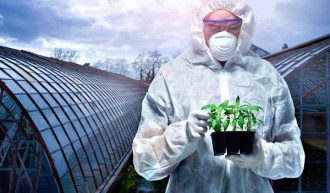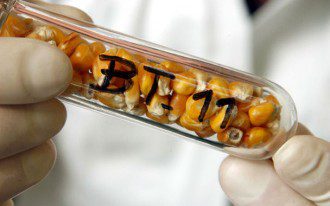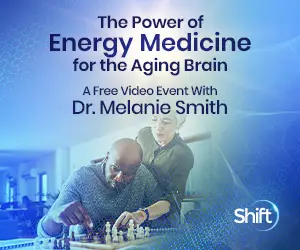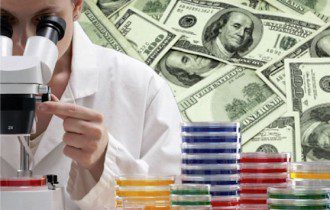Contributing writer for Wake Up World
Many of us are aware that genetically engineered (GE) foods and genetically modified organisms (GMOs) are harmful to health and the environment. But how can you effectively respond to friends and family who have fallen for the oft-repeated fallacies and myths about GMO safety and efficacy?
Claire Robinson is the editor of GM Watch, which is based in the U.K.. Together with genetic engineers Drs John Fagan and Michael Antoniou, she also co-authored the book “GMO Myths and Truths,” which can be a very helpful resource.
I was really impressed with Steven Druker’s landmark book, “Altered Genes, Twisted Truth,” which decimates most of the GMO proponent arguments. Sadly most proponents fail to ever read his book. Steven’s book is longer and a more challenging read for most, while “GMO Myths and Truths” is very concise and to-the-point, and it does a great job of providing you with strong arguments to effectively counter nonsensical GMO propaganda.
Robinson has been involved in the GMO debate since 1999. Her initial concerns were not incited by environmental groups, but rather by scientists.
“I knew some genetic engineers in the 1990s,” she says. “They were warning about the possible effects on health and the environment of genetically modified foods. At the time, I just didn’t want to think about it because there were too many other things to worry about.
But it became increasingly urgent that we do something, because before we knew it, there was talk about Monsanto wanting to genetically engineer every food crop on the planet, and I thought, “This is something we should be concerned about.”
The scientific voices did not die away. They were still warning about the possible effects of these foods. That’s really how I got involved…[My co-authors and I] noticed there was this rumor out there that activists against GE crops had no science on their side, that they were uneducated, and that they were irrational. We knew that that wasn’t the case.”
That’s what led to the creation of the book. In fact, it was written for the explicit purpose of arming people with facts to counteract claims that there is no scientific basis for concern.
Myth: GMOs Are Just an Extension of Natural Breeding Techniques
Many GMO proponents claim that genetic engineering is just an extension of natural breeding methods, and just as safe. Nothing could be further from the truth — on both counts.
Genetic engineering is radically different from conventional breeding techniques used to improve a crop. For starters, it’s a laboratory-based technique allowing scientists to create a food that could never be created by nature. As explained by Robinson:
“Genetic engineering enables DNA to be transferred not only between different kinds of plants, but even between different kingdoms. You can take DNA from an insect, an animal, a virus or a bacterium, and insert it into the genome of a food crop plant.
This is actually a very imprecise process. The truth is that the genetic engineering process disrupts the genome (organization and function of genes) of the plant. As a result we found time and time again that there are unexpected effects on the plant that is genetically engineered.
They tell us that it’s exactly the same, except for the inserted gene that’s been deliberately put in…But this isn’t the case. The genome is very complex. It’s not like Lego; you can’t just take out one bit, put in another bit, and expect there to be no knock-on effects.”
Unintended and Unforeseeable Side Effects Abound
There have been many occasions where the GE crop has been unexpectedly toxic or allergenic when the non-GE crop had no such issues. The reality is that scientists really don’t know what they’re doing in terms of what side effects are produced by DNA tampering. The effects are very unpredictable.
Genetic engineers are just now starting to admit this. Ironically, many of the drawbacks of genetic engineering, including the fact that it’s imprecise, were not openly admitted until they came out with a new technique, called genome editing and using, for example, CRISPR technology, which is said to be far more precise than earlier methods.
Alas, even genome editing techniques such as CRISPR create off-target effects, according to Robinson. So we’re still far from knowing all there is to know about genetic manipulation.
Why CRISPR Technology Will Not Remove Concerns
While the use of CRISPR-cas 9 allows more precise genetic engineering in one respect, in that you can target a genetic alteration including foreign gene insertion to a specific area of the genome, the potential for unintended effects remain, for the simple fact that when you alter one or two genes in a genome the side effects ripple through the whole genome.
In addition, just as with conventional genetic engineering, genome editing involves using plant tissue culture (plant cells grown under laboratory conditions), which has a wide-scale DNA mutagenic (damaging) effect in its own right. This too can dramatically alter the function of multiple gene functions.
Thus the off-target effects of genome editing and plant tissue culture-induced mutations can combine to bring about alterations in plant biochemistry.
One or more new proteins could be created in the process, which could be toxic or allergenic, or you could change the biochemical pathways of a plant, making it less nutritious or more toxic.
“In addition, most genetically engineered plants are engineered to either express an insecticide or to tolerate being sprayed on by an herbicide (weedkiller).
That means you’ve got the potential toxic effects of the herbicide residues that are sprayed on the plant or of the insecticide that is engineered into the plant,” Robinson notes.
The risk of unintended consequences is so high that even if scientists restricted the genetic engineering to the alteration of just one or two host plant genes or the insertion of genes into a plant into the very same species, say from corn to corn, these problems still would not disappear. As Robinson explains:
“The important thing when you’re genetically engineering a plant is the new context of the gene that you’re putting in. Even if you were to take a gene out of apples and put it into apples, you don’t really know what that’s doing, because all of a sudden the gene is in a new context.”
GMO Creation Is a Cruel and Wasteful Enterprise
Genetic engineering is also a very wasteful process. You create an enormous number of plants that are deformed, infertile, or otherwise not viable, so there’s a lot of waste. When it comes to the creation of GE animals there’s also the moral aspect of creating so many non-viable life forms.
“One of the scientists who I’m in contact with happened to see some GE salmon that were created in the research and development phase. He said it was really shocking, because there were salmon that were green in color. There were salmon that had lumps all over their bodies. All these had to be thrown away… I think it’s a very cruel process, because you’re creating so many non-viable animals, and you have to dispose of them.”
Long-Term Safety Studies Are Sorely Lacking
“GMOs are proven safe,” is the oft-repeated refrain. But where is the actual evidence for this? And what’s the strength of that evidence? While few in number, longer-term animal feeding studies have been published over the past several years showing there’s definite cause for concern. Liver and kidney toxicity and immune reactions tend to be the most prevalent. Digestive system, inflammation and fertility problems have also been seen.
“I think we’re all concerned about the state of people’s immune systems these days. Obviously it is a huge concern. I think any substance you feed to a laboratory animal and get an immune response [from], you really have to ask more questions about it,” Robinson says.
A major part of the problem is that safety studies conducted for regulatory purposes to gain market approval for a GE product are too short to show the damage that could occur from life-long consumption of the GE food. Some independent studies looking at lifetime consumption of GMOs have found rather dramatic health effects, whereas the safety studies used to promote GE foods as safe have all been short-term.
As noted by Robinson, there seems to be an agreement among biotech scientists to not test GE foods longer than 90 days in rats, which is only about seven to nine years in human terms. That’s nothing when you consider the average lifespan is somewhere in the 70’s, and the current generation is fed GMO food from day one.
“Typically, even in industry tests for 90 days in a rat, you can see signs of liver and kidney toxicity, and immune responses… What happens is they just dismiss the findings. They say, ‘These are not biologically relevant findings. We don’t need to do longer testing.’ This is a really an unscientific, worrying phenomenon. We should be doing long-term testing and multigenerational testing as well with all GE foods to get to the bottom of what is going on.”
Making matters worse, carefully calculated barriers have been erected by the GE industry to prevent independent researchers from ever doing those kinds of studies in the first place. Anyone purchasing GE seeds must sign a contract that forbids them from supplying them to researchers who do research, and in most cases the companies refuse to provide seeds to independent researchers.
Myth: Hundreds of Millions of GMO Meals Served With No Adverse Effects
Another completely unscientific and dishonest claim used to justify the use of GMOs is that Americans have eaten hundreds of millions of GMO meals with no ill effects. But who’s actually checking? No one is assessing and keeping tabs of potential side effects. You can’t even make that connection since GE foods are not labeled.
Despite that lack of traceability, health statistics clearly show Americans have been getting increasingly sicker over the past few decades. Chronic diseases are definitely increasing, and children are increasingly coming down with diseases that in the past did not arise until much later in life. No one can say for sure that there’s a link to GMO consumption since they’re not labeled and therefore cannot be tracked, but you certainly cannot ignore the possibility of a link either.
Myth: Without GE Crops We Cannot Feed the World
Another common claim is that we need GMOs because without them we don’t stand a chance to feed our growing population. This is nothing but a flawed fantasy, and there are at least half a dozen truths that dispel it.
Part of the myth is that GE crops provide greater yield, but they don’t. There is no gene for high yield. The GMO genes inserted are for creating herbicide tolerance or to produce internal insecticide. There is no way of genetically engineering high yield into a crop as it is dependent on complex multi-gene interactions, which GE cannot deliver.
However, conventional breeding methods are helpful for increasing yield as they can introduce the required multi-gene families into the crop. So a high-yielding GE crop is simply a crop that has been conventionally bred to produce high yields. Then the genetic engineers inserted an herbicide-tolerant gene or an insect-resistant gene into that plant.
The U.S. Department of Agriculture (USDA) even admits that yield is dependent on the background genetics of the crop; it is not dependent on the genetic engineering. In some cases the GE crop ends up yielding less than its non-GE equivalent.
That is certainly the case with GE soy, where there is what is known as a yield drag. It yields less than the non-GM soy. Exactly why is still unknown, but Robinson suggests it may be caused by the disruptive effect of the GE transformation process, or perhaps the GE plant’s energy is somehow used up in resisting herbicide, for example, and therefore has less energy left over for growth.
Soil Destruction Promotes Food Scarcity
GE plants — courtesy of the herbicides used — also destroy the microbial health of the soil. Ultimately, you need the microbes in the soil to nourish the plant, and it’s this symbiotic relationship that provides good yields.
From a long-term strategic perspective, destruction of topsoil is the greatest threat to the future of food, and if we continue in this way, people will starve no matter what GE plants they come up with. It’s a prescription for disaster. Once you implement regenerative agriculture you almost automatically create far greater yields, as these time-honored traditions nourish and build soil health.
“There’s some very good long-term research done at the Rodale Institute which shows that year upon year, the yields with organic systems can go up and up and up, because the soil fertility and health, including microbial life, is being built. Also, organics yield better in drought conditions, because there’s more organic matter in the soil, which acts like a sponge and it can hold water.
If we’re thinking about resilient agriculture that’s going to tide us through climate change and everything else the future can throw at us, it’s really all about agroecology, organic, and building soil. We certainly don’t want to be killing soil by putting glyphosate or other pesticides on it.
We do know that putting glyphosate herbicide on the soil actually ties up trace metal nutrients within the soil. It makes them less available to the plant and less available to us when we eat those plants,” Robinson says.
The World Health Organization’s International Agency for Research on Cancer (IARC) has also classified glyphosate as a probable carcinogen. Over 80 percent of GE plants are engineered to tolerate being heavily doused with glyphosate-based herbicides such as Roundup.
Worryingly, laboratory tests have shown that commercial formulations such as Roundup, which are complex mixtures of chemicals, are up to 1,000 times more toxic than glyphosate in isolation. Roundup gets incorporated into the entire plant and cannot be washed off, so when you eat those plants, you’re eating a general toxin and potential carcinogen.
Myth: GMOs Reduce the Need for Herbicides and Insecticides
Genetic engineering was sold as a means to reduce the amount of herbicides and other chemicals being used, but the reality is quite the opposite. GE crops have increased the use of pesticides, mostly because of herbicide-tolerant crops designed to survive huge amounts of herbicide. As weeds have developed resistance, farmers are forced to use ever-greater amounts of chemical mixtures.
Research by Dr. Charles Benbrook shows that because of GE crops, we have sprayed 7 percent more pesticides than we would have done had those same acres been planted with non-GE crops. That amounts to 404 million pounds of additional pesticides.
In addition to that, as of 2012, more than 61 million acres of U.S. farmland was covered with glyphosate-resistant super weeds. To address these weeds, even more toxic chemicals are being employed, such as Dicamba and 2,4-D (which is an ingredient of Agent Orange). So not only are we using more herbicides, we’re also using increasingly toxic ones.
“Also, there’s a UN report1 called the International Assessment of Agricultural Knowledge, Science and Technology for Development (IAASTD), which was published in 2008 by over 400 world scientists. It was on the future of food and the future of agriculture. They did not endorse the idea that GE crops were needed to feed the world.
They pointed out that the yields of GE crops were ‘variable,’ as they put it. In some cases, a GE crop might yield more; but in other cases, they don’t. Also there were lingering safety concerns over them. They said that the key to feeding the world and future generations will be agroecology.”
Who Benefits From GE Crops?
The answer is the companies that patent and own them. Profit is the real reason why GE crops are pushed so relentlessly in spite of the fact that they don’t yield more and they don’t reduce pesticide use. When you patent a GE crop, you not only own the rights on the particular crop, you also own the breeding rights.
Every crop bred from that GE crop, as long as your proprietary patented genes are in that progene, you own the progene as well as the original crop. So patenting GE seeds is a means of consolidating control over the food supply by a few big companies.
The U.S. government does nothing to prevent this, and the reason for that is because there are perpetually revolving doors between the industry and the government. It’s gotten to the point where the USDA is in practical reality a mere extension of Monsanto and other chem-ag giants, implementing and enforcing the industry’s recommendations.
“Michael Taylor is a case in point. He was an attorney for Monsanto. He crafted the biotech policy that enabled these foods to be marketed onto world markets from the USA. Michael Taylor oversaw the creation of that policy. He was basically an attorney for Monsanto, and still is. People often think that Europe is somehow better. Unfortunately, our own European Food Safety Authority (EFSA) has been absolutely infiltrated by industry-linked people.
There’s a body called the International Life Sciences Institute (ILSI), which is basically funded by Monsanto, Bayer, DuPont, and these big GMO companies. They’re this kind of scientific lobbying-style organization.
They are involved in crafting rules, regulatory rules to judge the safety of GE crops. They actually help to design them. A lot of these rules have now gone into the European regulatory process to judge whether a GE crop is safe. Basically, we can say the industry helped to write its own examination.”
Public Scientists Are Also Motivated by Greed
As revealed in Steven Druker’s book “Altered Genes, Twisted Truth”, the collusion between the industry and the government would never have been possible had it not been for the early molecular biologists who collectively agreed to allow genetic engineering of plants to proceed, and intentionally insulated the public from the risks. Still to this day, many public scientists have jumped on the bandwagon to support GMOs because they see it as a way to get funding from the industry.
“I’ve actually quizzed some of them about the animal feeding studies with GE crops. Not only have those scientists never read an animal feeding study on GE crops – I’m not talking about all of them here, just a few examples who I’ve met – but they see no reason why they should.
One of them said to me, ‘Why should I read those studies?’ I said, ‘Because you’re genetically engineering our plants.’ ‘Oh, what harm can possibly come of it,’ he says. ‘It’s just a matter of moving around a few genes. It’s nothing very scary.’ Again and again, we see this arrogant attitude.”
GMO Research Is Being Aggressively Thwarted
Not only do independent researchers rarely get access to GE seeds to perform their research, they also have few means of funding since they’re not interested in bending to the will of the industry. Industry funds most research, and they have a long history of “motivating” their scientists to reach certain conclusions.
Without funding, there’s not much a concerned scientist can do. Even if you manage to get funding from some government agency, they will often demand you have an industry partner to put up part of the money.
Moreover, those who have somehow managed to get around all of these obstacles to do these kinds of studies and reach negative conclusions typically end up being ostracized by the scientific community. Many have lost their jobs, and have had their entire scientific careers go up in flames. As noted by Robinson:
“It certainly is true that if you are a scientist who draws attention to risks of GE crops or whose research shows such risks, you are in danger of losing your job. You are in danger of never getting funding from anybody ever again. I’ve seen this happen now so many times that it is predictable.
Scientists have basically entered a cage voluntarily, if you can use that word “voluntarily” of this situation. Basically, they don’t ask the awkward questions. They don’t do the awkward research that may show the problems with GE crops. They stay clear of it.A friend of mine actually got together some independent funding for GMO risk research in the form of an animal feeding study. They approached a university and said, ‘Here, we’ve raised some money. Please, can your scientists research the safety of this GE crop when fed to animals?’ The scientists would not touch that money because they were frightened of losing their jobs. This is a very, very serious situation.
If we’re seriously interested in finding out the truth about GE crops, if we’re interested in finding out more than we already know, it’s going to come down to the public putting up the money and finding scientists who somehow will never need to worry about industry funding ever again. Probably they have to be retired or they have to be very, very unusual people.”
More Information
In this interview, we’ve only touched upon a few aspects covered in great depth in “GMO Myths and Truths.” I highly recommend picking up a copy to help you dispel the many myths circulating about GMOs. It’s really an invaluable reference if you’re seeking to learn the facts behind the arguments presented by GMO proponents.
SAD NEWS: House Passes DARK Act Compromise
The House passed a compromise to the DARK Act that will force food distributors to disclose the presence of genetically “engineered” (GE) ingredients with a smartphone scan code. It’s now headed to the White House, where President Obama is expected to sign it.
Genetically modified organisms (GMOs), or genetically “engineered” (GE) foods, are live organisms whose genetic components have been artificially manipulated in a laboratory setting through creating unstable combinations of plant, animal, bacteria and even viral genes that do not occur in nature or through traditional crossbreeding methods.
GMO proponents claim that genetic engineering is “safe and beneficial,” and that it advances the agricultural industry. They also say that GMOs help ensure the global food supply and sustainability. But is there any truth to these claims? I believe not. For years, I’ve stated the belief that GMOs pose one of the greatest threats to life on the planet. Genetic engineering is NOT the safe and beneficial technology that it is touted to be.
The FDA cleared the way for GE (Genetically Engineered) Atlantic salmon to be farmed for human consumption. Thanks to added language in the federal spending bill, the product will require special labeling so at least consumers will have the ability to identify the GE salmon in stores. However, it’s imperative ALL GE foods be labeled clearly without a smartphone scan code because not everyone owns a smartphone.
The FDA is threatening the existence of our food supply. We have to start taking action now. I urge you to share this article with friends and family. If we act together, we can make a difference and put an end to the absurdity.
Boycott Smart Labels Today
When you see the QR code or so-called Smart Label on a food product, pass it by. Products bearing the Grocery Manufacturer’s Association’s (GMA) Smart Label mark are in all likelihood filled with pesticides and/or GMO ingredients.
The GMA’s 300-plus members include chemical technology companies, GE seed and food and beverage companies. Monsanto, Dow and Coca-Cola are just some of the heavy-hitters in this powerful industry group, which has showed no qualms about doing whatever it takes to protect the interest of its members.
Don’t waste your time searching through their website, which may or may not contain the information you’re looking for. If they insist on wasting your time and making your shopping difficult, why reward them with a purchase? A little known fact is that the GMA actually owns the “Smart Label” trademark that Congress has accepted as a so-called “compromise” to on-package GMO labeling, and that’s another reason why I believe the Smart Label mark is the mark of those with something to hide such as Monsanto.
Will you financially support a corrupt, toxic and unsustainable food system, or a healthy, regenerative one? There are many options available besides big-brand processed foods that are part of the “GMA’s verified ring of deception.” You can:
- Shop at local farms and farmers markets
- Only buy products marked either “USDA 100 percent Organic” (which by law cannot contain GMOs), “100 percent Grass-Fed,” or “Non-GMO Verified”
- If you have a smartphone and you don’t mind using it, download the OCA’s Buycott app to quickly and easily identify the thousands of proprietary brands belonging to GMA members, so you can avoid them, as well as identify the names of ethical brands that deserve your patronage
Last but not least, encourage good companies to reject QR codes and to be transparent and clear with their labeling. This will eventually ensure that all GMO foods can easily be identified by the GMA’s “verified ring of deception” mark that is the Smart Label.
Campbell’s, Mars, Kellogg’s, ConAgra and General Mills all vowed to voluntarily comply with Vermont’s GMO labeling law by labeling all of their foods sold across the U.S. Will their plans change if the current “compromise” gets passed by the Senate? That remains to be seen, but if you like these companies, I would encourage you to reach out to them and ask them to remain steadfast in their promise.
Non-GMO Food Resources by Country
If you are searching for non-GMO foods, here is a list of trusted sites you can visit.
- Organic Food Directory (Australia)
- Eat Wild (Canada)
- Organic Explorer (New Zealand)
- Eat Well Guide (United States and Canada)
- Farm Match (United States)
- Local Harvest (United States)
- Weston A. Price Foundation (United States)
Article sources:
Recommended articles by Dr. Joseph Mercola:
- Why Depression is NOT Caused by a Chemical Imbalance
- The Health Benefits of Intermittent Fasting
- Can a Hug a Day Keep Infection Away?
- The Harmful Effects of Electromagnetic Fields Explained
- The Magic Healing Power of Mushrooms
- 13 Mind-Body Techniques That Can Help Ease Pain and Depression
- The Cancer Revolution: A Helpful Program to Reverse and Prevent Cancer
- Maternal Fluoride Exposure During Pregnancy Correlates to Lower IQ in Their Children
About the author:
 Born and raised in the inner city of Chicago, IL, Dr. Joseph Mercola is an osteopathic physician trained in both traditional and natural medicine. Board-certified in family medicine, Dr. Mercola served as the chairman of the family medicine department at St. Alexius Medical Center for five years, and in 2012 was granted fellowship status by the American College of Nutrition (ACN).
Born and raised in the inner city of Chicago, IL, Dr. Joseph Mercola is an osteopathic physician trained in both traditional and natural medicine. Board-certified in family medicine, Dr. Mercola served as the chairman of the family medicine department at St. Alexius Medical Center for five years, and in 2012 was granted fellowship status by the American College of Nutrition (ACN).
While in practice in the late 80s, Dr. Mercola realized the drugs he was prescribing to chronically ill patients were not working. By the early 90s, he began exploring the world of natural medicine, and soon changed the way he practiced medicine.
In 1997 Dr. Mercola founded www.Mercola.com, which is now routinely among the top 10 health sites on the internet. His passion is to transform the traditional medical paradigm in the United States. “The existing medical establishment is responsible for killing and permanently injuring millions of Americans… You want practical health solutions without the hype, and that’s what I offer.”
Visit www.Mercola.com for more information, or read Dr. Mercola’s full bio and résumé here.

If you've ever found value in our articles, we'd greatly appreciate your support by purchasing Mindful Meditation Techniques for Kids - A Practical Guide for Adults to Empower Kids with the Gift of Inner Peace and Resilience for Life.
In the spirit of mindfulness, we encourage you to choose the paperback version. Delve into its pages away from screen glare and notifications, allowing yourself to fully immerse in the transformative practices within. The physical book enriches the learning process and serves as a tangible commitment to mindfulness, easily shared among family and friends.
Over the past few years, Wake Up World has faced significant online censorship, impacting our financial ability to stay online. Instead of soliciting donations, we're exploring win-win solutions with our readers to remain financially viable. Moving into book publishing, we hope to secure ongoing funds to continue our mission. With over 8,500 articles published in the past 13 years, we are committed to keeping our content free and accessible to everyone, without resorting to a paywall.












